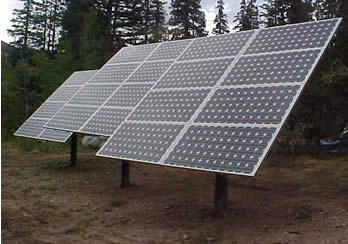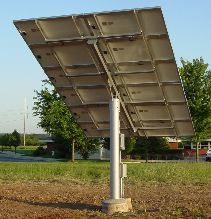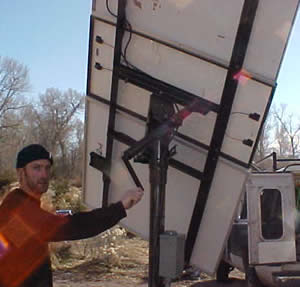Mounting Frames for Solar Modules:
The type of rack you need depends
on where the solar panels will be mounted. They are most often either mounted
on top of a pole or on a roof. Top-of-pole mounts can be either
stationary or trackers that follow the sun's movement across the
sky. Sometimes solar panels are mounted on a rack on the ground.
Roof Mounts come in two
basic types: flush and tilt-up.
Flush mount roof racks
keep the modules down on the roof, just a few inches above the roofing material.
This is the least obtrusive visually, and therefore is popular in suburbs
and higher-density residential areas. The major drawback of this mounting
system is that the solar array has to face whichever direction the roof
faces (which is usually not due south) and has to lie at the angle of the
roof's pitch (which is usually not the optimal angle). What this means in
real terms is that you don't get as much power out of your solar panels
as you could. They also tend to create higher temperatures for the panels,
which also slightly lowers their output. For this type of installation we
use either Unirac SolarMount or Conergy SunTop racks.
Tilt-up racks can be
angled up off a roof's pitch to the optimal angle for your area and can
be seasonally adjusted. They are more visually obtrusive than flush mount
racks, but in most instances they allow the panels to produce more energy.
Tilt-up racks can also be turned to face due south on a roof that faces
off south, again increasing energy production. Doing this, however, does
look awkward.
Ground mounted PV arrays can use the same racks as roof mounted tilt-up
arrays.
We usually prefer not to mount on roofs because of the potential
for leaks, difficulty of maintenance and over heating. However, a roof
mount is generally more secure from theft or damage, and sometimes offers
the best access to the sun.
Our prefered type of array mount
is the Top-of-Pole
rack. This type allows for easy seasonal adjustments for tilt
angle, is easy to install, keeps us installers off of roofs (with the
associated liability issues),and precludes roof penetrations (with the
associated leak potential). As compared to ground mounts, a top-of-pole
rack puts panels up into a position less prone to damage from lawnmower-thrown
rocks, etc. There are several manufacturers of top-of-pole racks that
don't meet our standards of stability and ease of use. Direct Power &
Water makes the best on the market -- we use them for almost all of our
pole mount installations.
 |
 |
|
|
We sometimes custom build top-of-pole racks to accomodate older
panels or odd combinations of panels.
Trackers are top-of-pole mounts
that use electronic sensors and motors to automatically
follow the sun's path. During cloudy weather they face the brightest part
of the sky to maximize the array's output. Trackers can increase an array's
power production by 10-50%, and are particularly effective in array direct
water pumping situations. (We no longer install or recommend passive trackers,
partially due to their tendency to flop around in the wind--which we have
plenty of here in the Southwest).
Wattsun
trackers, the only active trackers we recommend, come in single and dual-axis
models. Single-axis trackers follow the sun's path from east to west,
but they don't track the sun's seasonal changes, as the sun's angle gradually
rises in the sky from winter to summer and falls again from summer to
winter. With single-axis trackers, seasonal changes must be made manually,
in the same way as one would with a fixed top-of-pole rack. Single-axis
"tilt and roll" and "azimuth" type trackers are available.
Dual-axis trackers follow the sun's seasonal changes, as well as the daily
rising and setting of the sun.
As
with all motor-driven technology, reliability can be an issue with trackers.
Though Wattsun trackers provide many years of trouble-free service, they
do require occasional service calls. When a tracker malfunctions, it can
leave the array pointing toward the wrong part of the sky, leaving
its owner with a shortage of power.
The added cost vs. performance
boost of using a tracker usually adds up only with larger arrays. With
smaller arrays, it is usually more cost effective to simply buy an additional
panel or two.
 |
|
|
In response to customer requests we have developed the Manually
Trackable top-of-pole rack. With this, an array can turned to face
the sun if more power is needed in the morning or evening, and the
problems usually associated with trackers are avoided. Adjusting the direction
the rack faces is easily accomplished with a hand crank. When additional
gain isn't needed in the early or late hours of the day, the rack can
simply be set to due south and left alone. It will then function as a
regular top-of-pole rack. We can fabricate these to accomodate any size
array or combination of panels.
Do-it-yourselfers commonly respond
to the problem of mounting solar panels by constructing their own wood
racks. Telling you that this is a bad idea isn't simply an attempt
on our part to sell more products -- it truely is a bad idea. Improper
mounting and shoddy wooden rack construction, combined with wind, is the
#1 cause of damage to solar panels -- and we have seen many such instances.
However, we have never seen panels that were properly mounted on high
quality racks sustain wind damage. The problem with wood is that it rots
-- even pressure treated wood, even in a dry climate such as ours, in
New Mexico. Another major problem with wood is that it warps and twists
in the weather, putting stress on fasteners and panels alike (snapped
drywall screws is a common sight on wooden racks). In five years that
beautiful weekend project could be a major hazard to your investment.
But problems with rack construction are not limited to wood -- we have
seen some of the craziest metal contraptions designed to hold solar panels
you can imagine (complete with duct tape, bailing wire, and concrete blocks).
Trying to save a few hundred dollars by putting much more expensive solar
panels at risk is false economy. Modules cost a lot of money!
A quality rack should always be considered a necessary part of a solar
system!
| |
|
|
This module was mounted on a wooden rack! OH,
NO! |
Link to Catalog for Current Listings.
|